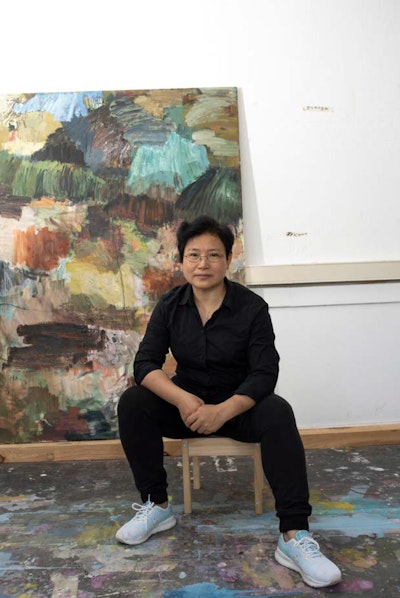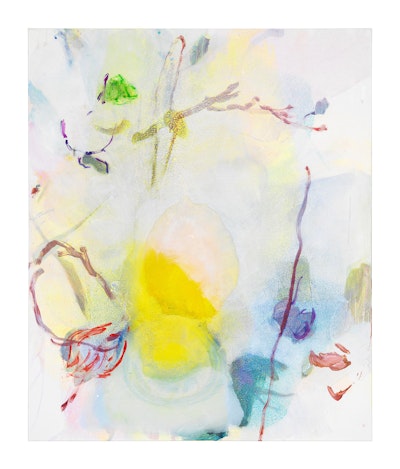Conversation in tandem with Michael Janssen (Michael Janssen Gallery) and artist Yafeng Duan, led by Emanuela Mazzonis
Emanuela Mazzonis: Good morning, Michael Janssen and Yafeng Duan. Thank you for participating in this cycle of interviews dedicated to a selection of galleries that are exhibiting at the Luxembourg Art Week for the first time. I would like to start by asking Michael to introduce his gallery, founded in Cologne in 1995, where it operated for twelve years and held over eighty exhibitions. In 2007, the gallery moved to Berlin, and in 2012, a second branch of the gallery opened in Singapore. The gallery runs a contemporary programme with predominately European, American and Southeast Asian artists.
Michael Janssen: Thank you. As you just said, the gallery was founded in Cologne in 1995. Besides its official location in Singapore from 2012 to 2015, it also ran another venue in Los Angeles, where it operated under the name The Happy Lion from 2002 to 2006. It was located in Chinatown, downtown Los Angeles. The gallery has always focussed on painting in its various guises, from abstraction to figuration. At the beginning, it represented mainly artists from the USA and Europe, but in 2011 the programme was expanded to include artists from Southeast Asia, such as Titarubi, one of the artists who represented Indonesia at the 2012 Venice Biennale, and the film and video artist Ho Tzu Nyen, who is now showing in biennials and museums worldwide. His first major solo show, entitled Phythagoras, was held at our Singapore gallery in 2013.
EM: Yafeng, your paintings are inspired by nature – nature as a mirror of the soul. Their colours refer to the colours of nature and their soft shapes seem to float on the surface and expand beyond the frame towards an abstract space that surpasses our imagination. Your compositions are delicate but at the same time full of energy and movement. They remind me of Kandinsky, whose paintings are characterised by musicality and the quest for inner beauty. Kandinsky believed that different shades of colour resonated with each other to produce visual ‘chords’ that touch the human soul. In your paintings, I also see a concert of colours and shapes that create a kind of spiritual expression. Nature, spirituality, materiality, abstraction, harmony, beauty – how do these themes play out in your art?
Yafeng Duan: You said that the colours in my paintings refer to the colours of nature – I would put it a little differently. They relate to my experiences and my feelings about natural phenomena, not to the colours of nature as such. The same applies to the shapes in the paintings. I experience nature in each moment. The birds leave their footprints on the snow. The branches sway with the wind. The sky changes colours at sunset. The birds chirp softly in the twilight. The morning air smells of earth and sky. The rain clouds drift by in the wind and let their threads stream down. I strongly feel the different seasons and how living beings change under their influence. I like to experience nature with my nose, ears, hands and skin. I want to perceive what we cannot see with our eyes. It’s an inner connection and a feeling of full presence. Time stands still and all other thoughts and sensations disappear. It’s a feeling of being completely filled with the perception of the majesty of the phenomenon.
MJ: Maybe I should briefly mention that I met Yafeng at the beginning of this year and visited her studio for the first time in spring. Before that I had only seen her paintings on photographs. I was really amazed at the effect that the interplay of nature and abstraction in her paintings has in reality. Yafeng paints with incredible precision. And while many of her subjects refer to traditional Chinese ink painting, she moves around the pictorial space with such ease that she always creates a virtuoso relationship between old traditions and expressive abstraction. One always senses an unbelievable calmness and strength emanating from her paintings. It’s really important to experience them physically.
EM: Michael, your gallery represents for the most part artists who work on canvas or on more or less traditional media. If we consider Cecilia Alemani’s Venice Biennale exhibition The Milk of Dreams – in particular the works of Louise Bonnet, Portia Zvavahera, Christina Quarles, Jana Euler, Allison Katz and Charline von Heyl – could we say that there is a return to painting in art? Michael and Yafeng, do you believe that contemporary artists will continue to paint – in a society increasingly dominated by digital media and devices that are already starting to replace artistic manual skills?
YD:This brings me back to the question of spirituality in my art that you mentioned earlier. Kandinsky spoke of the artists’ ‘fine sense of perception’ as something inaccessible to most people, and he believes it’s the artists’ task to make these perceptions accessible to others through their work. I also see the phenomena I described earlier as ‘fine perceptions’, atmospheric anticipations of the essence of natural phenomena. My paintings are very atmospheric, they are made up of numerous layers of thickly applied or glazed paint. The various layers interact and shine through each other. Some colours flow smoothly onto other layers of paint, while others have clear contours. Both methods work together and create tension. My paintings invite viewers to immerse themselves. The voids in the painting invite viewers to project their own interpretation onto the work. The pictorial elements radiate out of the painting in all directions. This living environment in front of, or around, the painting can be felt, but unfortunately they are difficult to capture on camera. I don’t care if my paintings are ‘beautiful’ or ‘harmonious’ because they reflect my inner reworkings of natural phenomena. As I said earlier, what matters is their inner resonance, the fact that they enable viewers to perceive the essence of things.
EM: Finally, I would like to ask Michael if he can briefly tell us what his booth at the fair will look like.
MJ: So far, Yafeng’s work has hardly been shown internationally, which is why I decided to present a solo exhibition at the fair that demonstrates the diversity and uniqueness of her work. She will be showing either one or two large-format works and a number of smaller formats.

